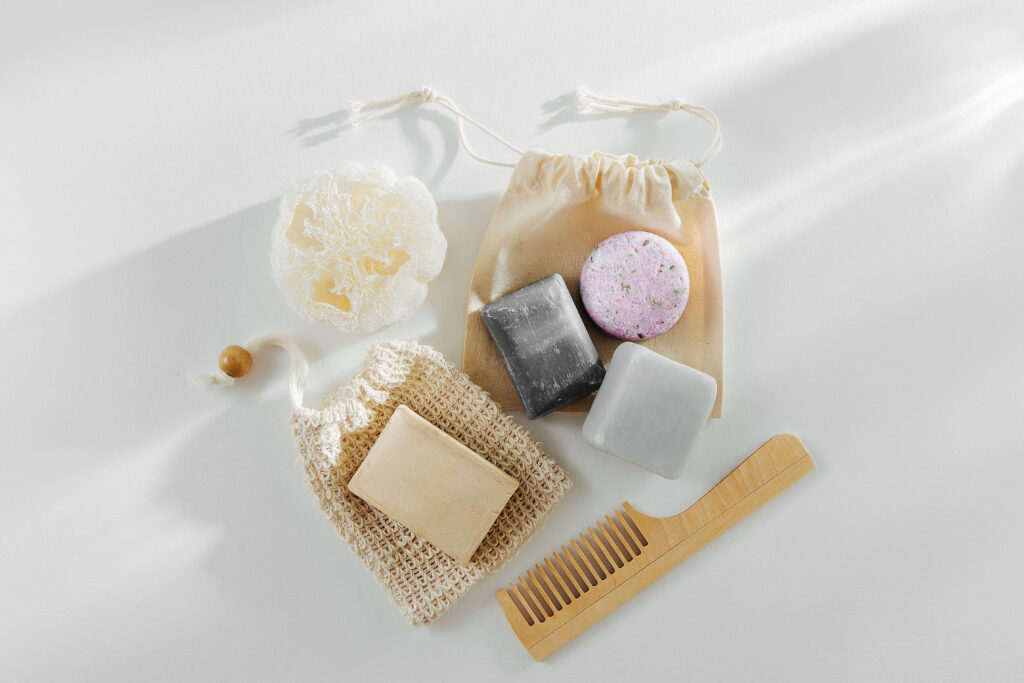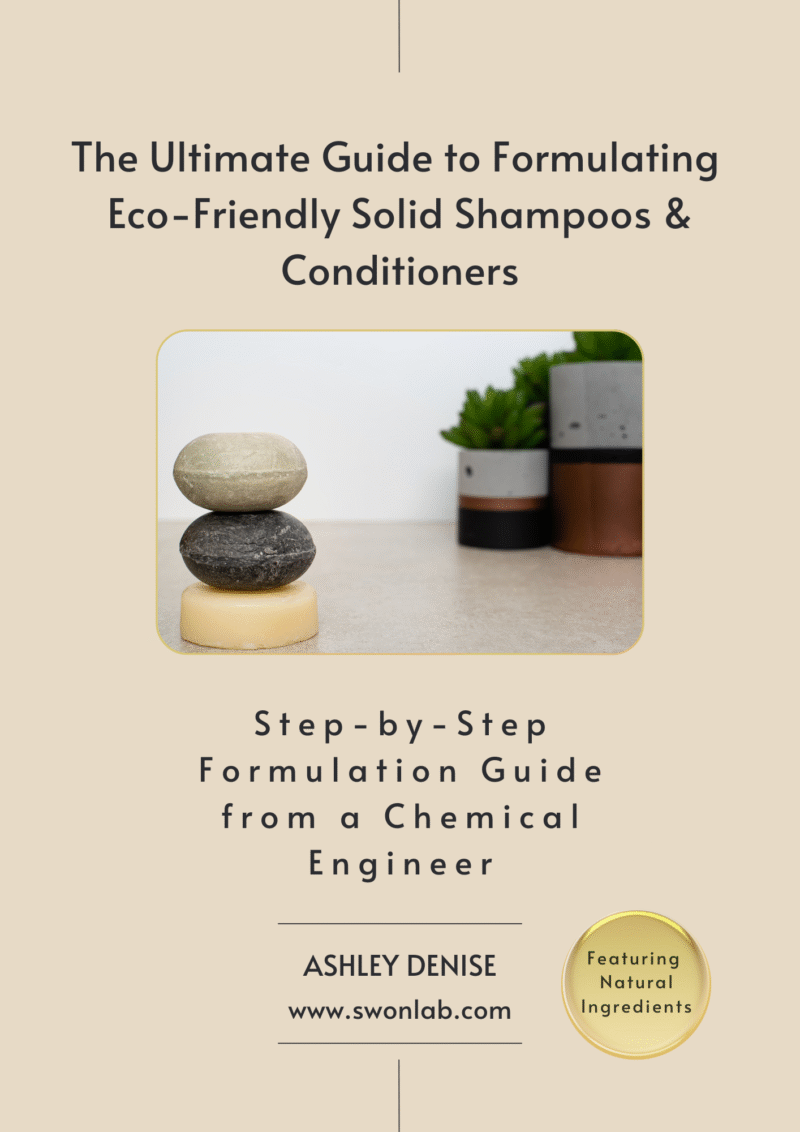When it comes to choosing the right shampoo, the question many eco-conscious users are now asking is: solid shampoo or liquid shampoo? At first glance, it might just seem like a matter of texture or packaging — but if you’re formulating your own or switching to a more sustainable haircare routine, the difference runs much deeper.
Solid shampoos are rising in popularity, not just because they look aesthetic and travel well, but because they promise less plastic, longer shelf life, and a more concentrated formula. But are they truly better than liquid shampoos? And what should formulators consider before making the switch?
In this guide, we’ll break down the core differences between solid shampoo vs liquid shampoo — from formulation and preservation to environmental impact. Whether you’re a DIY beginner or a seasoned skincare brand owner, this post will help you understand what works best for your product goals and your values.
What’s the Real Difference Between Solid and Liquid Shampoo?
At their core, both solid and liquid shampoos aim to do the same thing: cleanse the hair and scalp. But the way they’re formulated, preserved, packaged, and even experienced by users is surprisingly different — especially from a formulator’s perspective.
Here’s a breakdown of the most important contrasts between the two:
🧴 Liquid Shampoo
- Water-Based: Typically made with 60–80% water
- Needs Preservatives: Higher risk of microbial growth
- Easier to Apply: Lathers quickly and spreads easily
- Bulkier Packaging: Usually sold in plastic bottles
- Shorter Shelf Life: Especially sensitive to contamination
- Beginner Friendly: Easier to adjust and remix during testing
🧼 Solid Shampoo Bar
- Waterless: Made with dry surfactants and binding agents
- More Concentrated: Little to no dilution; less product per use
- Preservation-Safe: No water = lower microbial risk (🔸Still, it’s smart to include preservatives — solid bars are often exposed to water during use, especially in steamy bathrooms or wet storage conditions.)
- Eco-Friendly Packaging: Often sold in paper or tins
- Longer Shelf Life: Especially if stored dry and cool
- Requires Heat/Form: Often made via hot or cold process with molding
💡 Formulation Tip:
Solid shampoos require extra attention to ingredient compatibility, melting behavior, and texture. They need to look like soap, feel good in the hand — but perform like a salon-quality shampoo. Liquid shampoos are easier to tweak during testing, but they come with more packaging waste and storage demands.
🧪 Formulation Breakdown: Ingredients Compared
Solid and liquid shampoos may seem similar at first glance — after all, both are designed to clean the hair and scalp. But the ingredients used (and how they’re balanced) vary significantly due to texture, water content, and manufacturing methods.
Let’s break it down 👇
🔹 Surfactants
- Liquid: Typically uses water-dispersed surfactants like Sodium Laureth Sulfate, Cocamidopropyl Betaine, or Decyl Glucoside.
- Solid: Depends on powdered or flaked surfactants like SCI (Sodium Cocoyl Isethionate), SLSa, or SCS. These need heat to melt and bind properly.
💡 Solid bars require a careful balance of surfactants to ensure they foam well without becoming too harsh or too soft.
🔹 Water Phase
- Liquid: Usually contains 60–80% distilled water or floral hydrosols.
- Solid: No added water. This absence reduces the need for preservatives but affects how actives and extracts are incorporated.
💡 In solid bars, water-based actives can still be used — but they must be added as powders or in minimal doses, and require careful compatibility checks. Oil-soluble or anhydrous alternatives are often preferred for better stability.
🔹 Oils, Butters & Emollients
- Liquid: Oils are usually added in small amounts or emulsified; too much can separate or reduce lather.
- Solid: Emollients play a bigger role in texture and glide. Butters like cocoa or mango help firm the bar and nourish the scalp.
💡 Solid bars rely more heavily on the structure provided by fats — you’re not just treating the hair, you’re shaping the entire formula.
💧 Conditioning Agents & Active Ingredients
🔹 Conditioners
- Liquid Shampoos: Often use cationic polymers (like Polyquaterniums) or emulsions that leave a smooth film on the hair. These ingredients must be carefully selected to avoid incompatibility with the primary anionic surfactants.
- Solid Shampoos: Commonly use cationic surfactants like BTMS-50, Varisoft EQ 65, or Aminosensyl™ HC, which offer both conditioning and structure to the bar.
💡 Formulation Note:
Cationic ingredients carry a positive charge, which helps them cling to the negatively charged hair surface — making hair feel softer, smoother, and easier to detangle.
However, in liquid systems, cationic and anionic surfactants can form insoluble complexes, leading to separation or cloudiness. That’s why most liquid shampoos either skip cationic conditioning agents or use specially designed polymer systems that are compatible in mixed-charge environments.
🧪 Solid bars, on the other hand, are more flexible in this regard — the lack of water allows formulating with cationic ingredients without immediate phase issues.
🔹 Active Ingredients
Both solid and liquid shampoos can deliver active ingredients — but the way you formulate them makes a big difference.
- Liquid Shampoos are water-based, so they naturally work well with water-soluble actives like panthenol, niacinamide, peptides, and botanical extracts. These ingredients dissolve easily and remain bioavailable in the aqueous phase.
- Solid Shampoos, being anhydrous, require a more strategic approach. While oil-soluble actives (like squalane or CoQ10) integrate easily, you can still include water-soluble actives such as panthenol or hydrolyzed proteins — as long as you take care with their form and processing.
💡 For example, DL-Panthenol in powder form is more stable in solid bars than liquid versions. Hydrolyzed keratin can be used in small amounts, preferably added during the cool-down phase to preserve its function.
During use, water from the shower activates and dissolves these actives — so they still perform on the scalp and hair. The key is to use the correct form, avoid excessive heat, and store bars in dry conditions to prevent early degradation.
🌍 Sustainability & Packaging: Which One’s Greener?
Formulation isn’t just about ingredients — it’s also about the environmental footprint your product leaves behind. And when it comes to sustainability, solid shampoo bars win on multiple fronts.
🧴 Liquid Shampoos
- High Water Content: Most liquid shampoos are made of 60–80% water — meaning you’re shipping diluted products across the world.
- Plastic Packaging: Typically packaged in bulky plastic bottles that are rarely recycled fully.
- Heavier Carbon Footprint: More weight and volume in shipping = more emissions.
- Frequent Repurchasing: Liquid formulas run out faster, encouraging more packaging waste.
🧼 Solid Shampoo Bars
- No Water to Transport: You’re only shipping concentrated active ingredients — not water.
- Minimal, Plastic-Free Packaging: Often sold in recyclable paper boxes, tins, or wrapped in compostable material.
- More Product Per Gram: A single solid bar often lasts 2–3 times longer than the same weight in liquid shampoo.
- Shelf & Travel Friendly: No risk of leaking, easy to carry, and TSA-approved for travel.
🧠 Did you know?
A well-made solid bar can reduce packaging waste by over 90% compared to its liquid counterpart — without compromising performance.
💭 Transitioning from Liquid to Solid Shampoo: What to Expect
Switching from liquid shampoo to solid bars isn’t just about reducing plastic — it’s a shift in how your scalp and hair interact with cleansing agents.
While many users love solid shampoos from the very first wash, others might notice a brief adjustment phase. This is especially common if you’re used to strong, clarifying surfactants that aggressively strip oil and buildup. Solid shampoos are often made with gentler, milder cleansers — which may feel different at first, but are actually more aligned with the scalp’s natural balance.
In some cases, your scalp microbiome and sebum production may need a little time to recalibrate. You might experience slightly different lather, texture, or scalp feel during this shift. Think of it not as a flaw, but as a recovery period — a way for your scalp to detox, rebalance, and return to a healthier baseline.
Consistency is key. Give your scalp a few washes to adapt, and you’ll likely notice your hair becoming softer, calmer, and more manageable over time.
📘 Ready to Make the Switch?
If you’re ready to start formulating your own solid shampoo — or just want to understand what really makes a bar perform well — our Solid Shampoo & Conditioner Bar eBook is the ultimate resource.
You’ll get science-backed insights, beginner-safe recipes, ingredient breakdowns, and expert tips to help you avoid trial-and-error.
Solid Shampoo & Conditioner Bar Formulation Guide – SwonLab eBook
A complete, science-based guide to formulating solid shampoo and conditioner bars. This 170+ page eBook includes cold & hot process methods, ingredient deep-dives, and professional-grade recipes using BTMS, surfactants, oils, and more. Beginner-friendly, eco-conscious, and results-driven.


